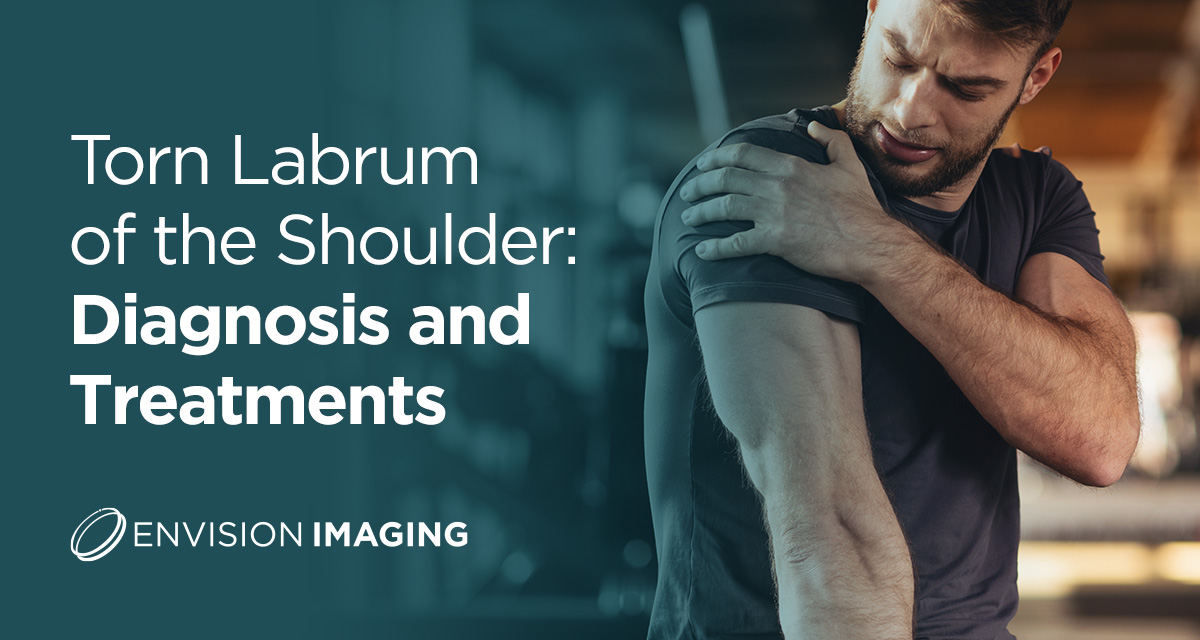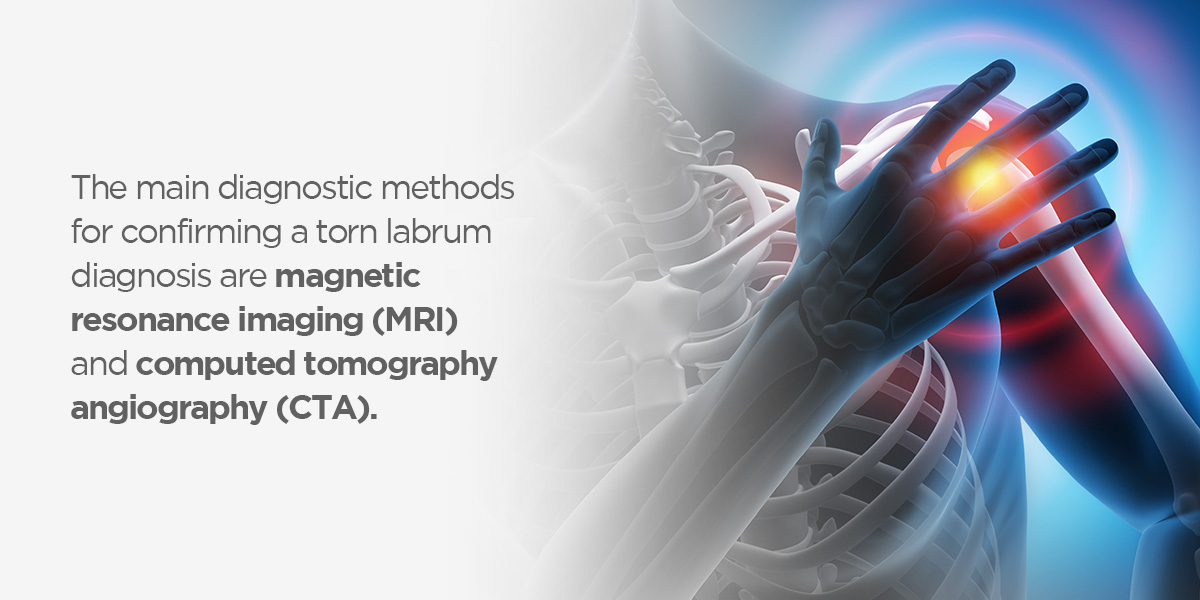Torn Labrum of the Shoulder: Diagnosis and Treatments
A torn labrum of the shoulder can cause significant pain and shoulder instability. If you’re dealing with a torn shoulder labrum, it’s important to get an accurate diagnosis so you can receive proper treatment. Learn more about torn shoulder labrum symptoms, diagnostic methods and treatment options below.
What is a torn labrum of the shoulder?
To understand what a labral tear of the shoulder is, let’s go through what a shoulder labrum is. Your shoulder is a ball-and-socket joint. As a ball-and-socket joint, the two bones that meet to form the joint fit together. With the shoulder joint, the ball is the head of your upper arm bone, or humerus. The socket of the shoulder joint forms part of your shoulder blade and is called the glenoid.
The humerus head and glenoid socket are lined with articular and labral cartilage. The articular cartilage is found on the edge of the ball and socket, while the labral cartilage is cup-shaped and follows your shoulder’s outer rim. As it lines and reinforces the shoulder joint, the labrum provides the shoulder joint with smooth and painless motion and keeps the humerus head inside the glenoid socket. The labrum is also the point where ligaments attach to the shoulder joint.
With that in mind, a torn labrum of the shoulder occurs when this cartilage tears or is otherwise damaged. There are two types of labral tears that affect the shoulder:
- Superior Labrum from Anterior to Posterior (SLAP) tear: A SLAP labral tear occurs where the biceps tendon connects to the shoulder labrum. This type of labral tear is often seen in baseball pitchers and volleyball players.
- Bankart tear: Bankart labral tears typically occur due to a dislocated shoulder, which happens when the shoulder joint ball slips out of its socket. A shoulder dislocation can cause the ligaments and tendons to pull on the lower labrum portion and tear it. When the labral tears due to shoulder dislocations, it creates further instability and increases the likelihood of repeat dislocations. This type of labrum tear is common in younger people with dislocated shoulders.
With that in mind, some common causes of labral tears in the shoulder include:
- Direct hits to your shoulder
- Dislocated shoulders, which labral tears can also cause due to the resulting shoulder joint instability
- Falling on an outstretched arm
- Fractured shoulders
- Overuse
- Repetitive motions
- Significant blows while reaching over your head
- Sudden tugs on one arm
Given those causes, sports like golf, baseball and tennis often see athletes tear their shoulder labrum.
Symptoms of a torn labrum of the shoulder
The symptoms of a torn shoulder labrum vary with the type of tear you experience. For example, with a SLAP labral tear, you may experience pain in the front of your shoulder. With a Bankart labral tear, you will likely experience increased shoulder instability and feel as though your shoulder could dislocate in various positions.
Some other symptoms of a torn shoulder labrum include:
- Grinding, popping, catching and clicking while moving the shoulder
- Pain when performing activities that require you to put your arms over your head
- Loss of strength and decreased range of motion with the affected shoulder joint
- Deep, achy pain that worsens at night
How to diagnose a labrum tear of the shoulder
The main diagnostic methods for confirming a torn labrum diagnosis are magnetic resonance imaging (MRI) and computed tomography angiography (CTA).
MRI
MRIs use magnetic and radiofrequency energy to produce detailed pictures of bones, joints and soft tissues on a processing display unit. The MRI machine is a large, tube-shaped structure that creates a strong magnetic field around patients and sends pulses of radiofrequency waves through the patient’s body.
During an MRI, the radiofrequency waves displace certain atoms in your body. As the atoms return to their original position, they transmit radio signals back. The MRI processing unit captures these radio signals and converts them into incredibly detailed, two-dimensional (2D) images that appear on a display screen.
An MRI scan takes anywhere from 30 minutes to two hours, during which time you’ll need to lie still. You’ll also be asked to hold your breath for a few seconds at a time at specific intervals. Right before the scan, you’ll lie on a padded table that enters the MRI tunnel. The MRI machine will produce various thumping, knocking and tapping sounds. For your comfort, you’ll receive a pair of headphones that play music during the MRI scan.
A shoulder MRI with contrast dye used is known as an arthrogram MRI. The contrast dye further enhances the image quality of the MRI data.
CTA scan
If you’ve ever had a CT scan, a CTA scan is the same except with contrast dye used to enhance image quality. CT scans use rotational x-ray technology to examine soft tissues, bones and blood vessels all at once. Comparatively, regular x-ray technology can only detect denser tissues. Like an MRI, CT scanners also consist of a machine with a tunnel. That said, the tunnel is much shorter, like a robotic donut.
With a CTA scan, you’ll receive contrast dye through an IV line in your arm or hand as you lie on an exam table before the procedure begins. The contrast material may produce a warm or metallic taste in your mouth. This side effect should quickly pass. Once you’re ready, the exam table you’re lying on will pass through the CT scanner.
As the scanner takes images, you will hear whirring and buzzing sounds. The scanner may also project lighted lines on your body that ensure you’re in the proper position. Most CT scans take between 15-30 minutes. A CTA scan will involve a bit more time to prepare you with the dye.
Treatments for torn labrum of the shoulder
Doctors often pursue noninvasive treatments for torn shoulder labrums before considering surgery. Some noninvasive treatment options for a torn labrum of the shoulder include:
- Corticosteroid injections
- Non-steroidal anti-inflammatory drugs (NSAIDs)
- Physical therapy
- Rest
If the torn labrum heals itself with these conservative treatment approaches, surgery is likely unnecessary. Most partial labrum tears do not require surgery. If the labrum is severely or completely torn, or if conservative treatments fail to bring relief, your doctor may recommend surgery. The main surgical option for a torn labrum of the shoulder is arthroscopic surgery.
With shoulder arthroscopy, the surgeon repairs the shoulder joint through a small incision. As they repair the joint, they will either remove the damaged cartilage, reattach the labrum and soft tissues or do both to restore joint motion. After the surgery, you’ll likely need to wear a sling for three to four weeks. During that time, you can perform light, painless exercises to regain shoulder strength and range of motion.
Request an appointment with Envision Imaging for a torn shoulder labrum diagnosis
If you think you’re dealing with a torn labrum of the shoulder, Envision Imaging can provide cutting-edge MRI or CTA services. Our world-class equipment helps provide an accurate diagnosis so you can receive the proper treatment.
Browse our locations to request your next diagnostic imaging appointment. Our world-class facilities, compassionate care and accurate results ensure a pleasant and reliable experience.




